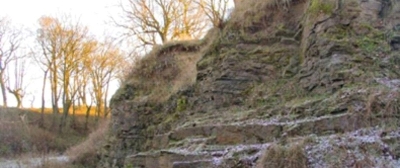4. East Kirkton Quarry, near Bathgate
This former limestone quarry outside Bathgate is now better known as an important fossil site in Central Scotland, with the famous fossil specimens Westlothiana and Balanerpeton woodi coming from here.

East Kirkton Quarry is a remarkable example of hot spring activity within a small volcanic lake. The East Kirkton Limestone found in the quarry formed during a period of volcanic activity around 330 million years ago, when a pile of basalt lava flows and ash layers built up in this area. Layers of calcium carbonate were precipitated as a result of the hot spring activity, forming a thinly bedded limestone which is exposed in the quarry. This limestone is unusual in that it was deposited in freshwater (most limestones form in shallow sea water). The quarry was worked in the early part of the 19th century when some fossils were found. The most important find occurred later, in 1984, when Stan Wood found fossils in a nearby stone wall and traced the rock to East Kirkton. This discovery was one of the most important in Scottish palaeontology during the 20th century. "Westlothiana" was previously thought to be the earliest known reptile, but is now considered to be closely related to the ancestors of that group. An equally important find from East Kirkton is "Balanerpeton woodi", an amphibian that belongs to the group which eventually evolved into today's frogs, toads and newts.
The quarry is located to the north of Boghall, which is just to the east of Bathgate. It is also a designated as a Site of Special Scientific Interest (SSSI). West Lothian Council allow access to the quarry with prior permission, but fossil collection is not permitted. Nearby sites are Petershill Quarries (26) and Rifle Range Quarries (27).



